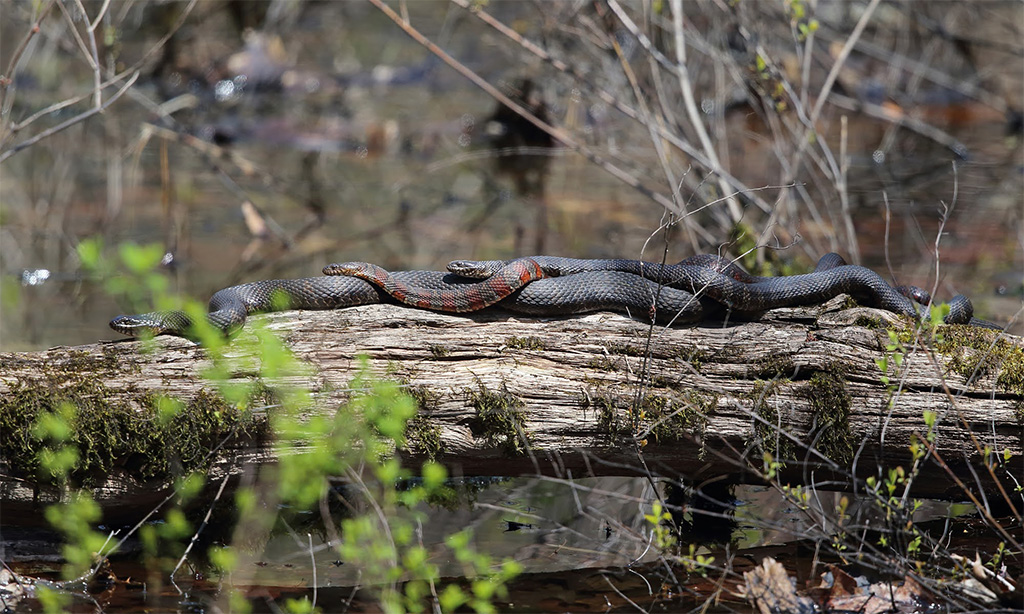Northern water snake will escape below surface, but if it can’t you should expect plenty of biting

Young water snakes have visible bands. Older snakes are usually a solid brown or black. (Photo: Tom Murray)
We do not encounter many snakes in Cambridge and Somerville, but there are a few, including the Eastern garter snake I have already written about and the northern water snake (Nerodia sipedon sipedon).
Snakes never stop growing, and water snakes are no exception. Older water snakes can reach 4 feet or more in length. Although the size makes water snakes seem frightening, these snakes are not venomous. In fact, Massachusetts has only two kinds of venomous snakes – the rattlesnake and the copperhead. These snakes are endangered and found in only a few isolated pockets in the state. Water snakes, on the other hand, are found near wetlands throughout.

Northern water snakes have rough scales, as seen on this water snake in Groton. (Photo: Tom Murray)
Although northern water snakes are not venomous, they can be quite aggressive. If you pick one up, corner it or touch it, it will bite you repeatedly. (So don’t do that.) It will also defecate and release a musky foul odor from scent glands in its cloaca (an opening on the tail used for excretion and reproduction).
Water snake saliva contains anticoagulants that inhibit blood clotting. These anticoagulants play an important role in incapacitating and digesting small prey. If a water snake bites a larger creature, such as a human, there might be more bleeding than usual from the wound for a few minutes, but otherwise the bite does not cause much harm.
Water snakes, like all snakes, are carnivores. As you might imagine, they are excellent swimmers, feeding above and below the surface. These snakes swallow live prey. During the day, they wait near shorelines to hunt mainly for frogs and salamanders, worms and crayfish, bird eggs and insects. At night, they hunt in the water for minnows and small fish.

A water snake this month in New Salem, where a woman had been sitting just minutes before. (Photo: Mark Rosenstein)
Water snakes hunt in the water by swimming with just their head above the surface. They detect prey with their eyes and keen sense of smell. They may also hunt below water by probing the bottom sediment with their snout.
Water snakes are hunted by many other species. Young snakes in particular are a favorite food for birds (herons, egrets, hawks), mammals (skunks, raccoons, foxes), fish (bass, pike), snapping turtles and even other snakes. For this reason, the snake must be a fierce fighter when cornered. When danger approaches, these snakes usually slip underwater, where they can remain submerged for 60 minutes or more.

Water snakes swim with their head above the water. (Photo: Richard George)
Water snakes have evolved to look a lot like the venomous cottonmouth snake (also called the water moccasin). This resemblance helps protect the water snake from predation by other animals, who think the water snake might be venomous and leave it alone. This similarity has made humans more likely to kill it, though. Since there are no cottonmouth snakes in Massachusetts – the nearest ones are in Virginia – there is no reason to fear this snake in Massachusetts.
In October, when frost arrives, water snakes begin their search for a winter den. They gather in groups where they will brumate for the winter. (Warm-blooded animals hibernate; cold-blooded species brumate.) The snakes stop eating, and their metabolism slows. They do not sleep, but they are inactive, since they are cold-blooded. A winter den might be a repurposed vole tunnel or muskrat burrow, a beaver lodge or dam, tree roots or rocky crevices. Water snakes usually emerge from their dens in late March or April. They are one of the last snakes to emerge in the spring.

Two male water snakes mate with a larger female in Groton, Massachusetts. (Photo: Tom Murray)
After coming out of brumation, water snakes mate in April or May. The snakes gather in large clusters, called aggregations. The male snakes compete with each other to mate with the larger females. To mate, a male twines his tail around the female and brings his cloacal opening in contact with hers. Females may mate with multiple males. Male snakes that are bigger are more likely to attempt mating, but research shows that the most successful males are not the biggest, as you might expect, but rather the males that produce the most sperm.
The female carries eggs that hatch inside her body. In late summer or fall, the female gives birth to 12 to 48 live youngsters, each about a foot long! The female snake does not care for the young; they are independent at birth. At first, young snakes catch mostly small fish. Once the snakes grow to 18 inches, they seek out larger prey such as salamanders and frogs.
If you walk quietly around a pond on a warm day, you might be lucky enough to spot an elusive water snake resting along the shoreline. It will probably glide into the water and slip away, but you can be happy knowing that the ecosystem is healthy if it supports all kinds of creatures.
![]()
Seen nearby

Quinton Zondervan photographed this red admiral butterfly drying its wings on an east-facing window this month in Cambridge.
![]()
Have you taken photos of our urban wild things? Send your images to Cambridge Day, and we may use them as part of a future feature. Include the photographer’s name and the general location where the photo was taken.
Jeanine Farley is an educational writer who has lived in the Boston area for more than 30 years. She enjoys taking photos of our urban wild things.



